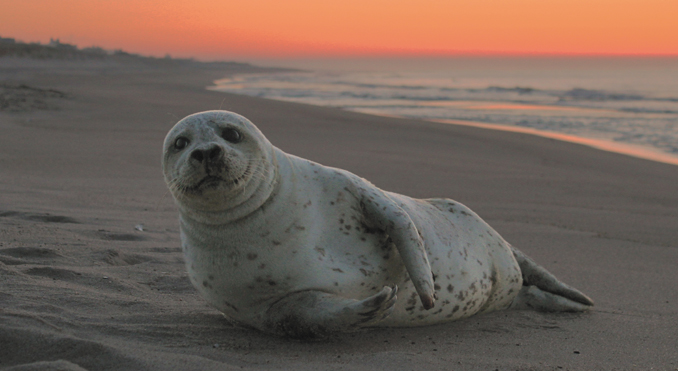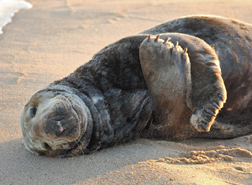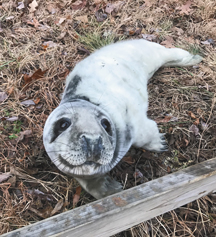
by Dell Cullum

I used the word semi-aquatic in the title of this month’s column because I think this is where most people get confused when they see a seal beached along any of our local shorelines. In fact, like most semi-aquatic species, seals actually do spend as much time on land as they do in the water yet I still get dozens of calls from folks each year concerned about seeing beached seals during their beach walks. Many often insist the animal is sick or injured, while others panic and report the seal to be in distress and dying simply because they are out of the water. Don’t get me wrong, sometimes a beached seal may be in distress and need help but, in most cases they do not.
I hope this little read will not only educate you about seals but also let you know what to do when you do come across a seal, how to observe, and how to tell if the seal needs help. So, let’s talk about the seal and the types we commonly see in our waters.
The seal is a pinniped. A group of marine mammals that live around the world, from the polar region to tropic water. They are divided into three families; Otariids, or seals with ear flaps (like fur seals & sea lions), Phocids or True Seals, better known as haired or earless seals (like our local seals) and Odobenids, the walrus. Of the thirty-three (33) species of seals, we can expect to see five (5) of them here on the east end of Long Island; the Harbor, Grey, Harp, Hooded, and Ringed Seals. Harbor seals make up approximately 95% of our local seal population. Grey seals are next at 4% and the remaining three make up the 1%. Let’s talk more about both the Harbor and the Grey seals, as these are the most commonly seen along our beaches.
Harbor seals are the ones most often seen lying across the rocks at Montauk State Park’s haul out site. A haul out is a location where seals feel safe leaving the water. It could be a rock protruding from the water’s surface or simply anywhere along a beach. When they leave the water, it’s called hauling out. All pinnipeds do this for a variety of reasons, such as reproduction, caring for young, absorbing heat from the sun and in most cases just resting. In rare cases it could mean the animal is injured or in distress, but we’ll talk more about that shortly. Harbor seals will sleep on both land and water. When they sleep in the water, they position their bodies vertically keeping only their heads above water. This is called “bottling”. Most seals sleep this way however, some species sleep completely submerged but remain close to the water surface.
Harbor seals can stay underwater for up to thirty minutes, but their average dive is only three minutes. They are very social animals, about six feet long and 175 – 225 pounds in weight. Their diet consists of fish, squid, crabs and crustaceans. They range in color from brown to grey with dark spots. They have a short coat of coarse guard hair with finer and fuller under hair. Their life expectancy is between 25 and 35 years. Harbor seals are commonly found in Maine and eastern Canada during the spring and summer, while in the winter they migrate south to our beautiful waters of Long Island. This also falls within their breeding season which ranges between February and April, and their birthing season of March through June. Young that are born prematurely will still have their whitish coat (called lanugo), but normally this coat is shed while in the womb. A newborn seal pup will weigh about 20 pounds and can swim at birth. Although it can only stay submerged for about two minutes, it’ll sometimes ride on its mother’s back when too tired to swim. Because the pups can swim at birth, Harbor seals often give birth in areas that are inundated at high tide, like tidal sandbars, reefs and pocket beach coves.

The Grey seal, or Horse-head seal, is a much larger seal species. I find that Grey seals are the ones seen most often beached along our ocean shorelines, particularly the younger pups. As their nickname implies, they have a much longer head and wider snout. Males can grow to almost three times the size of some females, reaching lengths of 8.5 ft and weighing close to 800 pounds. They usually sport a dark coat with light markings, whereas the females usually don the exact opposite. Adult females generally reach lengths of 6.5′ and weigh up to 450 pounds. These seals live between 30 and 50 years and are only found in the waters of the western North Atlantic. Grey seals feed mostly on schooling fish, squid, octopus, crustaceans, and sometimes even seabirds. Grey seals can stay underwater for up to 16 minutes at a time however, their average dive is usually only 5 to 8 minutes.

Grey seal pups are born with a thick white lanugo coat. This is shed in about two to four weeks. Because their mother’s milk spikes in fat content during lactation, pups with gain about 3 pounds per day. By three weeks they are usually weaned. At this point there are varying opinions but, from my personal research and experience I believe that although the bond between mother and pup is strong, Grey seal pups are precocial, meaning they can feed themselves almost immediately after birth. So, once weaned after 3 weeks, the mother leaves her pup on the beach and returns to sea. The pup is left with a nice supply of stored fat to give it time to shed its remaining coat and make that big move toward the water where it will learn to swim and find food on its own. THIS is the most vulnerable part of a Grey seals life, and THIS is when most folks run into these little guys along the beach, or in even more unique locations like along a roadside or in someone’s backyard. It’s almost as if their instincts are still in development at this stage and besides a possible navigation mishap it could turn to a very serious issue if the seal doesn’t realize it needs to be in the water to find food. In fact, many researchers have found a large number of Grey seal pups die from starvation, due to this instinctual indecision.
Harbor seals pups are different. They will spend much time on a beach resting while their moms are away feeding, sometimes as long as 48 hours. More often than not, a Harbor seal pup does not need help. If you’re an avid beach walker, you might want to learn to identify these two seals. It would be vital information if you decide to report the sighting, which is fine however, don’t assume the seal is sick or injured unless there are more obvious indications like cuts, bleeding, etc.
Like all marine mammals, seals are federally protected by the Marine Mammal Protection Act of 1972. It is highly illegal to touch, harass or harm a marine mammal, or allow a pet to do so. They will bite if threatened and their bite can cause serious infections. Please observe seals from a distance and keep pets far away. If you need to report an injured seal, sea turtle or other marine mammal, PLEASE contact the Riverhead Foundation for Marine Research & Preservation HOTLINE at 631-369-9829. If you’re able to send them a photo of the seal it’ll help them tremendously.
Wildlife and Marine Life Matters.
~ Dell Cullum
Evelyn Alexander Wildlife Rehab and Rescue: 631-728-WILD
Hampton Wildlife: 631-377-6555

